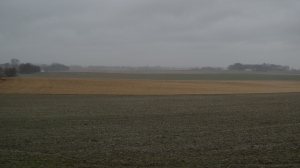What a fitting day to visit the battleground of Waterloo!
February 28, 2010: Driving rain, 4 degrees celsius, 100Km/hr winds – down right ugly – do you get the picture? This trip was optional for Nutmeg, not so much for Ginger but they both decided to go along and learn something. What Nutmeg figured out really quick is to get out of the bus in the driving rain was stupid and she could learn all about the battle inside the comfort of the vehicle. Ginger felt he should support his classmates and stand outside until he totally soaked along with the camera.
Here is a short version of the long version we heard on the bus:
The Battle of Waterloo was fought on Sunday 18 June 1815 near Waterloo in present-day Belgium. An Imperial French army under the command of Emperor Napoleon was defeated by combined armies of the Seventh Coalition, one an Anglo-Allied army under the command of the Duke of Wellington and the other a Prussian army (Germany before it was formed) under the command of Gebhard von Blücher. It was the culminating battle of the Waterloo Campaign and Napoleon’s last. The defeat at Waterloo put an end to Napoleon’s rule as Emperor of the French and marked the end of his Hundred Days’ return from exile.
Napoleon delayed giving battle until noon on 18 June to allow the ground to dry. Wellington’s army, positioned across the Brussels road on the Mont St Jean escarpment, withstood repeated attacks by the French, until, in the evening, the Prussians arrived in force and broke through Napoleon’s right flank. At that moment, Wellington’s Anglo-allied army counter-attacked and drove the French army in disorder from the field. Pursuing Coalition forces entered France and restored Louis XVIII to the French throne. Napoleon abdicated, surrendered to the British, and was exiled to Saint Helena, where he died in 1821.
The battlefield is in present-day Belgium, about eight miles (12 km) SSE of Brussels, and about a mile (1.6 km) from the town of Waterloo. The site of the battlefield is today dominated by a large monument, the Lion Mound. As this mound used earth from the battlefield itself, the original topography of the part of the battlefield around the mound has not been preserved.
Needless to say for battle historians there are libraries built and waiting to be read on battles such as this one. For Nutmeg, the view of the waterlogged field of clay-based soil was enough to understand that horses and men with cannons had a really hard time getting through. The cavalry attrition rate was over 50%!!!! Nutmeg suggested to Ginger that might not have been a good way to get a promotion in those days…
Waterloo or Waterlogged? Either way it was a tough battle.
[tfb username=’GingerandNutmeg’ count=’true’ lang=’en’ theme=’light’]
Food Travel Tags:
Travel, Travel Belgium












